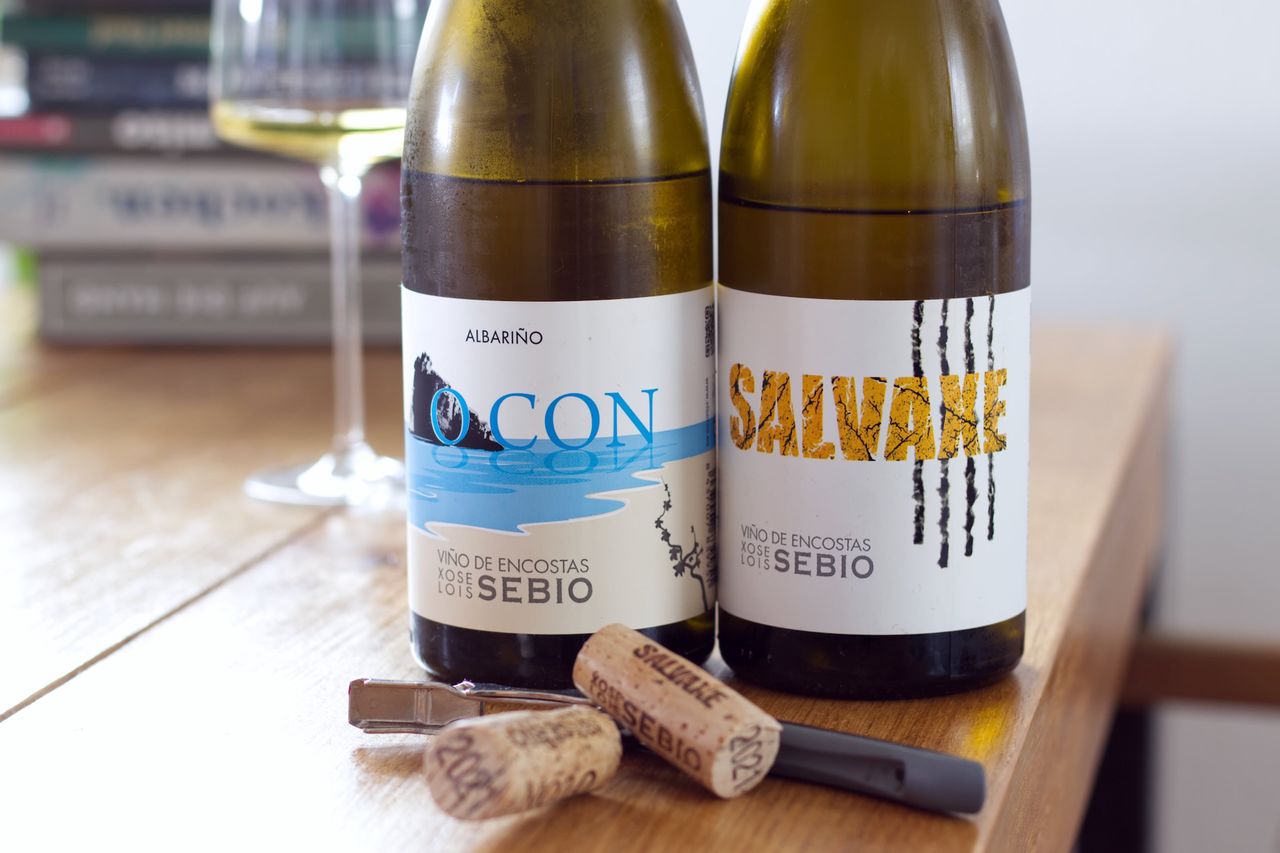Two Bottles Xose Lois Sebio
We are drinking two bottles of wine from Xose Lois Sebio's Viños de Encostas series: One bottle of O Con 2021 and one bottle of Salvaxe 2021.

The project of immediately emptying boxes instead of putting them away continues unabated. These two bottles are also a discovery from Perspektive Wein. Interestingly, I had never heard of Xose Lois Sebio before, and it was pure chance that he had set up his wines at the stand almost directly next to Can Descregut. Can Descregut wouldn’t have been familiar to me either, but as luck would have it, these exact wines were discussed a few days earlier on the WRINT Flaschen podcast. They are truly outstanding wines, by the way. So, one thing led to another, we had O Con and Salvaxe in the glass, and we knew immediately that those glasses needed to turn into bottles. Xose Lois Sebio makes wines in Galicia in northwest Spain. In addition to the wines from the family estate, grapes are purchased under the name Viños de Encostas from small producers who are supposed to express their respective terroir particularly well. Both wines today are from this series. The grapes are organically grown, biodynamically grown, or conventionally grown depending on the producer. All grapes come in small quantities from small, exceptional plots. Not all wines are produced every year. Only what works well and meets the winemaker’s standards finds the way into the bottle. The O Con is a single-variety Albariño, which grows on slate soils near the coast in Rías Baixas on vines about 75 years old. The wine starts fermentation in stainless steel and is then transferred to large wooden barrels to ferment further slowly at low temperatures. Salvaxe is a blend of Albariño, Treixadura, Godello, Verdello, and other grape varieties from vines between 70 and 110 years old in the Ribeiro region of the vineyard. Here, the term “Old Vines” takes on a completely different meaning. Like with the other wine, fermentation begins in stainless steel and then continues in wood. Aging takes place in a mixture of old and new wooden barrels for about 8 months.
The O Con appears fine and cool on the nose and at the same time intense. There’s more feeling than one could actually assign flavors to. Maybe a bit of pear. And even when drinking, there’s much more feeling than taste. No, I take that back, there is taste, there is a lot of taste, spice, freshness, structure. But just as when smelling, you feel all of this much more subconsciously than sitting there and thinking that it’s apple and lemon that you taste. It’s always a bit tricky with the origin and how much you actually taste when you already know where the wine comes from. But here too, you feel like the freshness of the salty sea breeze is blowing through the glass. And anyway, I immediately recall why I highlighted these bottles at the trade show.
Overnight, the aroma becomes a bit warmer. Even more intense, denser. There’s much more fruit now, more stone fruit, maybe some mango too. And in contrast, the development of the acidity, which now brings much more tension to the tongue. Then structure comes again, and in the end, a slightly yellow citrus fruit settles on the tongue. It feels a bit like the cream of a lime tart. Lots of freshness, lots of juiciness, the ethereal quality of freshly grated citrus zest, and a touch of sweetness. It feels less tight than on the first evening, fuller, but also more balanced. It grabs me just the same.
The Salvaxe reminds a bit of beer right after pouring. Somewhere between an IPA and a wheat beer with banana and much better than that may sound now. That’s probably the mix of minimal remaining yeast note, citrus, herbal notes, and the slightly yellow fruit. It adds another layer of intensity, it’s denser, more powerful. And when drinking, there’s more creaminess, more citrus, more yellow fruit, and also more intensity.
And this wine too becomes denser with a day more time in the open bottle. But in a different way. It remains much creamier, much more on the tongue than on the nose. There’s some smoke, melon, and stone. The acidity is more pineapple than citrus, softer, smoother, and more balanced. It nestles against the tongue before sliding down the throat. And it changes in the glass throughout the whole evening. There’s something floral at times, honeydew melon, and then the stone again. Both wines deserve time and attention. Certainly also time in the cellar because when researching, you often read how well the wines can age. I was too impatient for that with these two bottles. But I’m really glad we stopped at the stand. Our Spanish is just as bad as our French, but we still managed to communicate okay. Just this moment, I noticed that these two bottles are actually the first two white wines from Spain here on the blog. And in general, we really don’t have Spain in white in our glass often enough. So, it’s all the more beautiful to have made such a discovery.